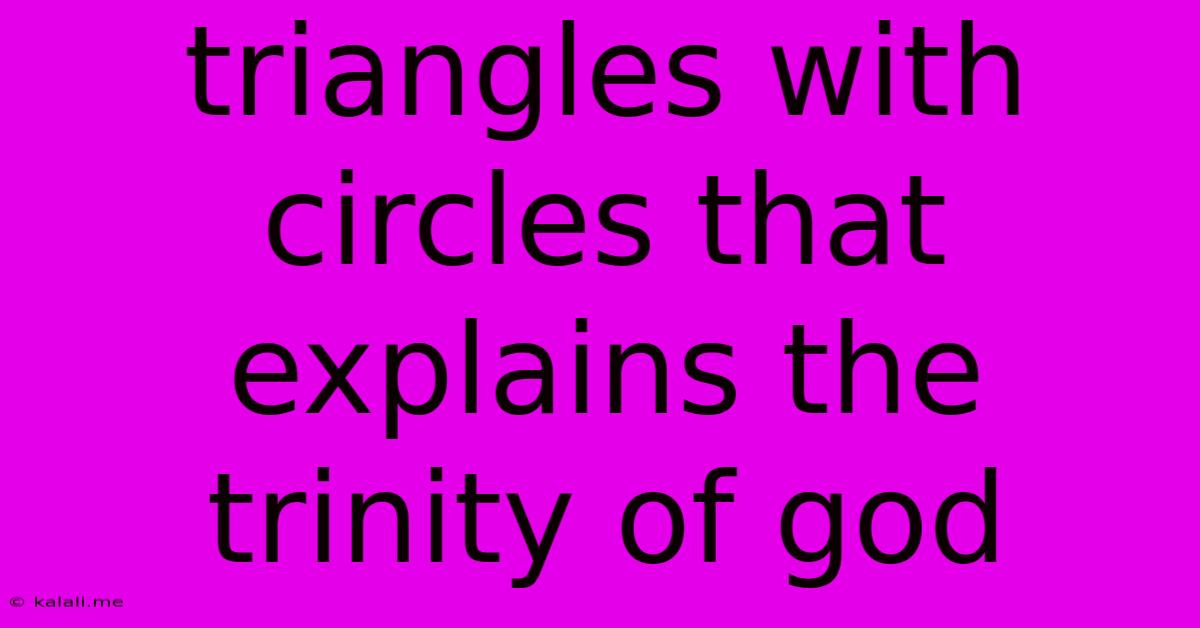Triangles With Circles That Explains The Trinity Of God
Kalali
Jun 08, 2025 · 3 min read

Table of Contents
Triangles, Circles, and the Trinity: A Visual Exploration of God's Three-in-One Nature
The concept of the Holy Trinity – God as Father, Son, and Holy Spirit – is a cornerstone of Christian theology. While deeply theological, this profound mystery can be approached through various lenses, including visual representations. This article explores the use of triangles and circles in illustrating the Trinity, examining their strengths and limitations in conveying this complex doctrine. Understanding these visual aids can enhance our appreciation of this central Christian belief.
The Triangle: Representing Unity and Distinctness
The triangle, a three-sided polygon, immediately speaks to the three distinct persons of the Godhead: the Father, the Son (Jesus Christ), and the Holy Spirit. Each point of the triangle represents a distinct person, highlighting their individual characteristics and roles within the divine economy. This is a powerful visual representation because it simultaneously demonstrates the unity of the three persons within the single entity of God. The enclosed space within the triangle symbolizes the oneness and indivisibility of the Godhead. The three distinct points, however, retain their individual identity.
Advantages of the Triangle:
- Clear Representation: The three points clearly illustrate the three persons of the Trinity.
- Unity and Distinction: Simultaneously depicts the unity of God and the distinct nature of the Father, Son, and Holy Spirit.
- Simplicity and Elegance: Its simplicity makes it a readily understandable visual aid.
Limitations of the Triangle:
- Static Representation: It doesn't effectively convey the dynamic interplay and mutual indwelling of the three persons.
- Oversimplification: The complexity of the Trinity is potentially reduced to a simple geometric shape.
The Circle: Symbolizing Eternity and Interconnectedness
Circles, unlike triangles, have no beginning and no end. This characteristic lends itself beautifully to representing the eternal nature of God. The unbroken line of the circle also symbolizes the perfect unity and unbroken fellowship existing within the Trinity. Further, the continuous flow of the circle can be interpreted to represent the continuous and ever-present work of the three divine persons in creation, preservation, and redemption.
Advantages of the Circle:
- Eternality: The unending circle visually represents God's eternal nature.
- Unity and Interconnectedness: The unbroken line symbolizes the perfect unity and continuous interaction within the Godhead.
- Dynamic Flow: Represents the ongoing activity of God in the world.
Limitations of the Circle:
- Lack of Distinction: A single circle alone doesn't effectively convey the distinction between the three persons. It requires additional visual elements to effectively illustrate the Trinity.
Combining Triangles and Circles: A More Holistic Approach
The most effective visual representations of the Trinity often combine elements of both triangles and circles. For example, a triangle inscribed within a circle, or a circle divided into three sections representing the Father, Son, and Holy Spirit, can offer a more nuanced understanding. These combinations attempt to balance the need to show both the distinction of the three persons and their perfect unity in one Godhead. Such imagery provides a visual metaphor, a starting point for reflection and deeper theological exploration. Remember, any visual representation is ultimately a limited analogy, pointing towards a truth that transcends human comprehension.
Conclusion: Visual Aids as Tools for Understanding
Visual representations like triangles and circles serve as helpful tools for grasping the concept of the Trinity. While they can't fully capture the mystery of the divine, they offer valuable visual aids for contemplation and discussion. It’s crucial to remember that these images are symbolic; they point to a deeper reality that is ultimately beyond our complete understanding. They are prompts for further prayerful reflection and engagement with the profound truth of God's triune nature. Their purpose is not to define the Trinity but to inspire a deeper understanding of this central Christian doctrine.
Latest Posts
Latest Posts
-
Steering Wheel Shaking At 60 Mph
Jun 09, 2025
-
Monogram With Baskerville Bol 3 Letters
Jun 09, 2025
-
Isnull Vs Isempty Under Decision Element In Salesforce Flow
Jun 09, 2025
-
My Linux Partition Is Part Of My Windows Partition
Jun 09, 2025
-
Whats The Pttt Button For Rdo
Jun 09, 2025
Related Post
Thank you for visiting our website which covers about Triangles With Circles That Explains The Trinity Of God . We hope the information provided has been useful to you. Feel free to contact us if you have any questions or need further assistance. See you next time and don't miss to bookmark.